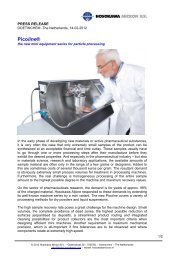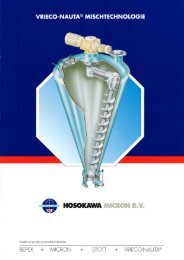Download - Hosokawa Micron BV
Download - Hosokawa Micron BV
Download - Hosokawa Micron BV
You also want an ePaper? Increase the reach of your titles
YUMPU automatically turns print PDFs into web optimized ePapers that Google loves.
Jos Giesen, managing director<br />
PARTICLE ENGINEERING & B INDERS<br />
>>> Page 1<br />
Strong and weak<br />
on demand<br />
Because of the high surface<br />
to volume ratio there is a<br />
lot of inter particle friction<br />
resulting in extremely bad<br />
flow characteristics.<br />
Fine and active particles<br />
have an increased need for<br />
a stable mixture with the<br />
other compounds, for application<br />
as well as during<br />
storage and transportation.<br />
A solution for the down<br />
sides, which are mentioned<br />
above, is particle enlargement.<br />
Agglomeration is a<br />
very effective process for<br />
this. Agglomeration is the<br />
binding together of particles<br />
with a liquid or another<br />
binder in such a way that<br />
the agglomerate does fall<br />
apart after drying.<br />
Therefore our title: Strong<br />
during transport and storage<br />
but weak when used for<br />
the final application.<br />
In this issue of the<br />
<strong>Hosokawa</strong> Herald several<br />
case studies and applications<br />
will give you a better<br />
view of the capabilities of<br />
the <strong>Hosokawa</strong> <strong>Micron</strong><br />
Group in this special field.<br />
Particle Engineering<br />
Mechanisms of particle size enlargement are complex and are important to understand to formulate<br />
recipes. The formulation for particle size modification needs to be adapted to be able to obtain the<br />
functionality we are looking for. The differences between the agglomeration phenomena are<br />
illustrated herewith below. In this edition mainly binding agglomeration is our concern. Depending<br />
on the functionality we would like to give to powders, what components needs to be part of the<br />
formulation, different type of binders could be used:<br />
• Polymer type like PVP or PVA: They are water soluble and of high quality. Excellent for<br />
compression / tableting.<br />
• Sugar type like sugar, glucose, maltodextrine or molasses. They are all soluble and often used<br />
in food/ feed<br />
•Water: Simple and could be often efficient if the formulation contains latent binding ingredients<br />
• Chemical type like Sodium silicate: Strong binder. In use in detergent and mineral applications<br />
•Pre - gelatinised starch type: Often used for limestone applications<br />
• Fat type like PEG or Stearic acids: Excellent for melt agglomeration with cooling after to fix<br />
agglomerates<br />
Depending on the type of binder you will use, strong, weak, flexible or brittle agglomerates can be<br />
obtained with good or bad wettability, dispersability, dissolving time, etc.<br />
A foreign binder is not always required because it could be already part of the formulation.<br />
Product characteristics<br />
There are different routes leading to the same end result. In other words: an enlarged particle can<br />
be designed in different ways. This does not mean that all those routes, read processes, are always<br />
available for any application. The evaluation of desired product properties is crucial selecting the<br />
right process. The table showed below is giving a qualitative relation between defined desired end<br />
product properties and specific shape of the end product.<br />
The presented different shapes are the result of the use of<br />
specific processes. This means in fact that a certain required set<br />
of properties is dictating a certain form, so a certain process.<br />
Agglomeration diagram<br />
As indicated already external binders are often required and play<br />
an important role for the granulation. As you can see above, not<br />
only the type is crucial but also the amount. Of course the product<br />
itself will tell you the maximum percentage you can use, but the<br />
general message here to understand is:<br />
More liquid means in most cases larger agglomerates till the point where<br />
it becomes a paste<br />
Selection table<br />
base<br />
product<br />
powder<br />
yes<br />
compact<br />
particle<br />
no<br />
shaped<br />
particle<br />
no<br />
endproduct<br />
< 1,5 mm<br />
yes<br />
Flexomix<br />
Fluidbed dryer<br />
PARTICLE ENGINEERING & BINDERS<br />
yes<br />
no<br />
base<br />
product<br />
filtercake<br />
no<br />
yes<br />
no<br />
low pressure<br />
compaction<br />
yes<br />
Flexomix<br />
Bextruder<br />
Spheronizer<br />
Fluidbed dryer<br />
spherical<br />
particle<br />
Particle size enlargement<br />
yes<br />
yes<br />
yes<br />
no<br />
no<br />
Flexomix<br />
Bextruder<br />
Fluidbed dryer<br />
continuous<br />
operation<br />
medium<br />
pressure<br />
compaction<br />
yes<br />
base<br />
product solution<br />
suspension<br />
slurry<br />
no<br />
no<br />
Extrudomix or<br />
Gear Pelletizer<br />
Fluidbed dryer<br />
yes<br />
high pressure<br />
compaction<br />
Bepex<br />
compaction<br />
line<br />
no<br />
no<br />
yes yes<br />
2 3<br />
Agglomaster<br />
Fluidbed<br />
processor<br />
base<br />
product<br />
powder<br />
yes<br />
compact<br />
particle<br />
Cyclomix




